Photography courtesy of Lowell Washburn, all rights reserved.
The sound had an immediate and paralyzing effect. A sound that could be fairly described as a roar, or perhaps a noise more akin to that of a huge and heavy canvas being rent in twain by some unseen force of nature. As it turned out, the latter would be a more apt description with the sky providing the ‘canvas’ and the ’unseen force of nature’ arriving in the form of a squadron of canvasback ducks rapidly descending to the decoys. Coming from behind, the ducks had taken me by surprise. With wings locked and landing gear already extended, there was little mystery concerning the bird’s intentions of joining the decoys. With stiffened pinions continuing to rend the autumn air, the flock’s first pass was fast and wide. But upon executing a hard bank, the bird’s returned at a somewhat reduced speed. The sight was mesmerizing, and the leading birds were already splashing among the decoys as I rose to fire. Benelli, my Chesapeake Bay retriever and every day hunting companion, lost no time in exiting the blind. Seconds later, she presented me with duck hunting’s ultimate trophy – a prime canvasback — the King of Ducks.
Perfect in plumage and heavy in hand, the duck was a perfect specimen. It isn’t every day that a hunter gets to hold a southbound canvasback. In the tradition steeped realm of American waterfowling, no species is more historically significant. During the halcyon days of the mid to late 1800s, canvasback ducks provided the very foundation for the [then legal] era of commercial gunning. In the days America’s early expansion, the continent’s vast natural resources — including its migratory birds — were thought to be without limit. And although not every American worker had the money, skill, or leisure time needed for the hunt, most families regularly included wild game in their diets — meat either acquired from friends or purchased at local markets. Even in those days of unfathomable abundance, the famed canvasback was not taken for granted. At bustling urban food markets, fresh canvasbacks brought two to three times the price of other fowl — including the popular redhead and mallard ducks.
But nowhere was the craze for canvasbacks carried to greater extremes than on the eastern seaboard’s Chesapeake Bay. It was here that mind boggling concentrations of ’cans gathered each winter to feed on the succulent roots and tubers of wild celery; and it was on these waters that the World‘s Greatest Duck Hunt took place. It was here that the species’ reputation for unrivaled table quality rose to legendary proportions. In the Eastern cultural hubs of Baltimore, Philadelphia, or Washington D.C., roast canvasback duck was first choice for the tables of the elite. Whether served as the main course at state dinners or featured on the finest hotel menus; the noble canvasback was the very last word in fine dining.
The canvasback’s culinary desirability hasn’t changed during the past century, and it remains a stellar moment whenever the bird falls into a hunter‘s possession. For contemporary waterfowl enthusiasts, bringing a ’can [or any other duck] to bag is merely the halfway point in a journey that ends at the table. If the canvasback truly is the King of Ducks, then it should always be treated as such.
What do I mean by that? Well, to begin with, canvasback ducks should be treated with the utmost respect from the very moment they’re brought to bag. Handle them gently. Keep them dry and keep them clean. Canvasbacks must always be plucked whole; never ever skinned or breasted– a barbaric and disgusting practice that shows little respect for the bird or for achieving its flavorful potential. Once plucked, whole canvasbacks display a remarkably light skin and, in most cases, are loaded with a delicate white fat. In order to achieve maximum flavor and tenderness, canvasbacks should be aged for a minimum of three to five days before roasting. I avoid all marinades and rubs on this one. Regardless of cooking methods, canvasbacks should be served rare [or for more squeamish diners] no more than medium-rare. Anything beyond that is guaranteed to reduce the appearance and quality of the presentation. It takes real talent to mess up a fat canvasback, and overcooking is the surest way to get on the fast track to achieving that goal.
When cooking day arrives, allow duck to warm to room temperature. Before cooking, I prefer to either brush the bird with butter or coat with oil before seasoning. My favorite seasoning is Durkee’s Six Pepper and I leave the body cavity empty. A properly aged canvasback is amazingly easy to prepare and should be cooked hot. By ‘cooked hot‘, I mean in an oven heated to a minimum of 450 degrees. Most ovens won’t get much hotter and it may take 20 or 30 minutes or more to attain that temperature. Most traditional ‘Down East’ duck dinners will include side servings of wild rice, bread dressing, oyster dressing, stuffed clams, or crab cakes. And although I dearly love them all and wouldn’t think of eating canvasback duck without at least one of those sides, I prefer to cook the ducks all by themselves in a separate dish or grate. It‘s not that cooking the ducks with wild rice or dressing isn‘t good; it is. Putting the birds by themselves is just what works best for me. Speaking of sides, roast canvasback represents a signature moment in dining, and you’ll want to go the extra mile. This is one table where Uncle Ben’s boxed rice mix or those cream of mushroom soup concoctions are definitely not welcome. Instead, pull all the stops and thrill guests with servings of pure Minnesota wild rice, fresh baked oyster dressing, or crab cakes prepared in your own kitchen.
OK — off my soap box and back to cooking. In spite of the fact that the canvasback is a very large duck, cooking time is surprisingly short — assuming that your oven is super hot. For a roaster containing one to three birds, 18 to 20 minutes will bring ducks to rare, while 20 to 25 minutes or so will bring them to medium-rare. [Remember that not all ovens or oven thermometers are created equal, and suggested cooking times are approximate; not absolute.] Once removed from the oven, ducks should be rested for 8 to 10 minutes before carving. Don’t forget that ducks will continue to “cook” as they rest. That’s one lesson that I’ve had to learn the hard way – and on more than one occasion.
I also enjoy preparing canvasbacks in outside covered grills. Utilizing indirect heat, I bank coals on opposite sides of the kettle and shoot for an initial high temp. The difference between this method and the indoor oven is that, although grill temperatures start high, the heat will steadily diminish during the cooking process. But since cooking times are relatively short with ducks, this decrease is much less of a consideration than when cooking larger birds like giant Canada geese or wild turkeys. For wood, I prefer apple or mesquite over hickory. While these milder woods will still impart a very desirable smoky flavor, they don’t overpower the bird’s natural qualities the way too much hickory can. Cooking times will approximate those of indoor ovens. Begin testing ducks after 20 minutes and remove from grill the minute — no, the second — juices begin turning from red to pink.
Once ducks have rested, it’s time to dish up the sides and to carve and serve the duck. This is no meal to rush. Take time to savor the moment; enjoy each precious and traditional flavor filled bite. But be forewarned. Once you’ve dined on a properly prepared wild canvasback duck, there’s no turning back and you’ll soon be entertaining thoughts of feeding your mallards to the cat. OK, — I’ll admit that that last statement was a bit of a stretch. Most duck hunters don’t own a cat.

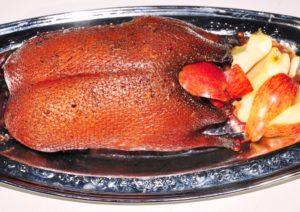
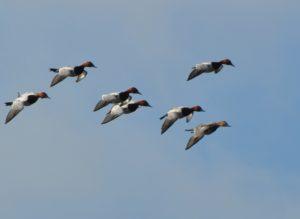
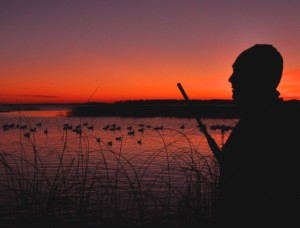

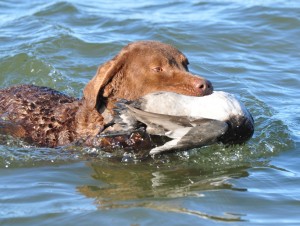

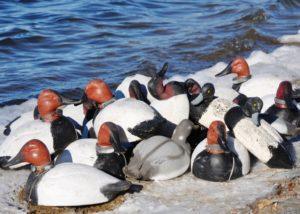
 Tom Cope
Tom Cope Sue Wilkinson
Sue Wilkinson Susan Judkins Josten
Susan Judkins Josten Rudi Roeslein
Rudi Roeslein Elyssa McFarland
Elyssa McFarland Mark Langgin
Mark Langgin Adam Janke
Adam Janke Joe Henry
Joe Henry Kristin Ashenbrenner
Kristin Ashenbrenner Joe Wilkinson
Joe Wilkinson Dr. Tammy Mildenstein
Dr. Tammy Mildenstein Sean McMahon
Sean McMahon